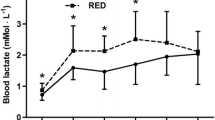Summary
This study examined the anaerobic and aerobic contributions to muscle metabolism during high intensity short duration exercise. Six males [mean (SD): age 25.0 (6.0) years, height 179.0 (8.2) cm, mass 70.01 (7.42) kg, \(\dot VO_{2max}\)4.63 (0.53) 1 · min−1, body fat 12.7 (2.3)%] performed three counterbalanced treatments of 30, 60 and 90 s of maximal cycling on an air-braked ergometer. All treatments were also performed on days when biopsies were not taken from the vastus lateralis muscle and cannulae not inserted into a forearm vein to ascertain whether these procedures adversely affected performance. The mean results can be summarised as follows: a Homogenate from vastus lateralis muscle; wm, wet muscle; b biopsies taken from vastus lateralis muscle and cannula inserted into forearm vein; c noninvasive procedures ATP, Adenosine 5′-triphosphate; PC, phosphocreatinine
The muscle lactate and O2 deficit data suggested that 60 and 90 s were more appropriate durations than 30 s for assessing the anaerobic capacity on an air-braked cycle ergometer. The mean power outputs also indicated that the invasive procedures did not adversely affect performance.
Similar content being viewed by others
References
Åstrand PO, Hultman E, Juhlin-Dannfelt A, Reynolds G (1986) Disposal of lactate during and after strenuous exercise in humans. J Appl Physiol 61:338–343
Bar-Or O, Dotan R, Inbar O (1977) A 30-sec all-out ergometric test: its reliability and validity for anaerobic capacity. Isr J Med Sci 13:326–327
Bar-Or O, Dotan R, Inbar O, Rothstein A, Karlsson J, Tesch P (1980) Anaerobic capacity and muscle fibre type distribution in man. Int J Sports Med 1:82–85
Bonde-Petersen F, Henriksson J, Lundin B (1975) Blood flow in thigh muscle during bicycling exercise at varying work rates. Eur J Appl Physiol 34:191–197
Clark DG, Rognstad R, Katz J (1974) Lipogenesis in rat hepatocyctes. J Biol Chem 249:2028–2036
Coggan AR, Costill DL (1984) Biological and technological variability of three anaerobic ergometer tests. Int J Sports Med 5:142–145
Czok R, Lamprecht W (1974) Pyruvate, phosphoenolypyruvate and D-glycerate-2-phosphate. In: Bergmeyer HU (ed) Methods of enzymatic analysis, vol. III. Verlag Chemie, Weinheim and Academic Press, New York, pp 1446–1451
Davies CTM, Sandstrom ER (1989) Maximal mechanical power output and capacity for cyclists and young adults. Eur J Appl Physiol 58:838–844
Essén B (1978) Studies on the regulation of metabolism in human skeletal muscle using intermittent exercise as an experimental model. Acta Physiol Scand 454 [Suppl]:1–32
Froese EA, Houston ME (1987) Performance during the Wingate anaerobic test and muscle morphology in males and females. Int J Sports Med 8:35–59
Fujitsuka N, Yamamoto T, Ohkuwa T, Saito M, Miyamura M (1982) Peak blood lactate after short periods of maximal treadmill running. Eur J Appl Physiol 48:289–296
Gutmann I, Wahlefeld AW (1974) L-(+)-lactate: determination with lactate dehydrogenase and NAD. In: Bergmeyer HU (ed) Methods of enzymatic analysis, vol. III. Verlag Chemie, Weinheim and Academic Press, New York, pp 1464–1472
Hermansen L, Medbo JI (1984) The relative significance of aerobic and anaerobic processes during maximal exercise of short duration. In: Marconnet P, Poortmans J, Hermansen L (eds) Physiological chemistry of training and detraining, vol. XVII. Medicine and Sport Science. Karger, Basle, pp 56–67
Jacobs I, Tesch PA, Bar-Or O, Karlsson J, Dotan R (1983) Lactate in human skeletal muscle after 10 and 30 s of supramaximal exercise. J Appl Physiol 55:365–367
Jones NL, McCartney N, Graham T, Spriet LL, Kowalchuk JM, Heigenhauser GJF, Sutton JR (1985) Muscle performance and metabolism in maximal isokinetic cycling at slow and fast speeds. J Appl Physiol 59:132–136
Karlsson J (1971) Lactate and phosphagen concentrations in working muscle of man. Acta Physiol Scand 358 [Suppl]:1–72
Katch VL, Weltman A, Martin R, Gray L (1977) Optimal test characteristics for maximal anaerobic work on the bicycle ergometer. Res Q 48:319–327
Kindermann W, Keul J (1977) Lactate acidosis with different forms of sports activities. Can J Appl Sports Sci 2:177–182
Lawson DL (1981) Maximal oxygen deficit as an indicator of anaerobic potential. Aust J Sports Med 13:50–54
Lowry OH, Passoneau JV (1972) Flexible system of enzymatic analysis. Academic Press, New York
McCartney N, Spriet LL, Heigenhauser HJF, Kowalchuk JH, Sutton JR, Jones NL (1986) Muscle power and metabolism in maximal intermittent exercise. J Appl Physiol 60:1164–1169
Medbø JI, Tabata I (1989) Relative importance of aerobic and anaerobic energy release during short-lasting exhausting bicycle exercise. J Appl Physiol 67:1881–1886
Medbø JI, Mohn AC, Tabata I, Bahr R, Vaage O, Sejersted OM (1988) Anaerobic capacity determined by maximal accumulated O2 deficit. J Appl Physiol 64:50–60
Padykula HA, Herman E (1955) The specificity of the histochemical method of adenosine triphosphatase. J Histochem Cytochem 3:170–183
Sainsbury DA, Gore CJ, Withers RT, Ilsley AH (1988) An on-line microcomputer program for the monitoring of physiological variables during rest and exercise. Comput Biol Med 18:17–24
Saltin B (1990) Anaerobic capacity: past, present and prospective. In: Taylor AW, Gollnick PD, Green HJ, Ianuzzo CD, Noble EG, Métiivier G, Sutton JR (eds) Biochemistry of exercise, vol. VII. Human Kinetics, Champaign, Ill. pp 387–412
Siri WE (1961) Body composition from fluid spaces and density: analysis of methods. In: Brozek J, Henschel A (eds) Techniques for measuring body composition. National Academy of Sciences National Research Council, Washington, DC, pp 223–244
Tabata I, Medbø JI, Vøllestad NK, Sejersted OM (1985) Glycogen breakdown and lactate accumulation during shortlasting exhaustive exercise in normal humans. Clin Physiol 5 [Suppl 4]:299
Vandewalle H, Press G, Monod H (1987) Standard anaerobic exercise tests. Sports Med 4:268–289
Withers RT, Telford RD (1987) The determination of maximum anaerobic power and capacity. In: Gass G (ed) Physiological guidelines for the assessment of the elite athlete. Australian Sports Commission, Canberra, pp 105–124
Withers RT, Whittingham NO, Norton KI, La Forgia J, Ellis MW, Crockett A (1987) Relative body fat and anthropometric prediction of body density of female athletes. Eur J Appl Physiol 56:169–180
Author information
Authors and Affiliations
Rights and permissions
About this article
Cite this article
Withers, R.T., Sherman, W.M., Clark, D.G. et al. Muscle metabolism during 30, 60 and 90 s of maximal cycling on an air-braked ergometer. Eur J Appl Physiol 63, 354–362 (1991). https://doi.org/10.1007/BF00364462
Accepted:
Issue Date:
DOI: https://doi.org/10.1007/BF00364462




